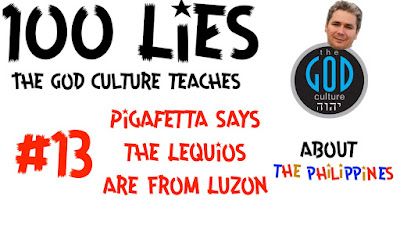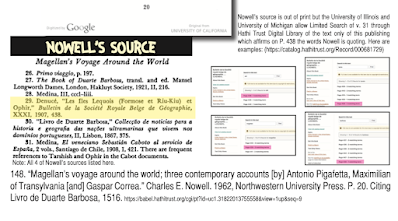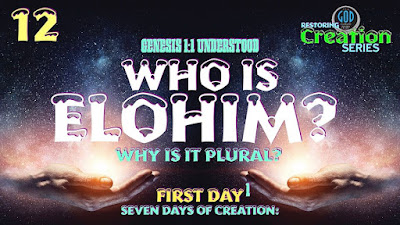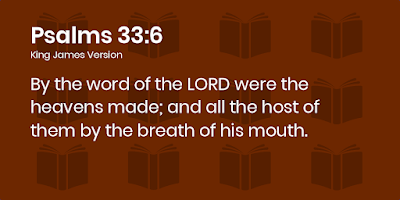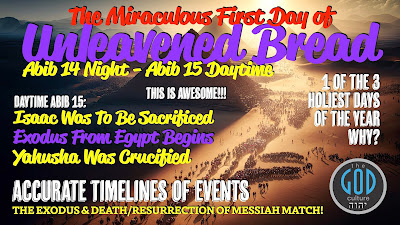Welcome back to 100 lies the God Culture teaches about the Philippines. Today's lie once again concerns the identification of the Lequios and Lucoes. Last time we looked at Timothy Jay Schwab's misunderstanding of Pigafetta's journal. Today we will look at his ignorance of Tome Pires' Summa Oriental.
Even though Tim does use Tome Pires as a source he does not have much to say about what he writes.
 |
| The Lequios of Luzon: Key to Finding Ophir and Chryse. Clue #52 |
18:31 Tome Pires writes The Leqouis bring swords worth thirty cruzados each and many of these. Many. Cool. It appears a cruzado is equal to that of a Spanish ducat. 30 ducats in today's value in gold would be about 4,500 US dollars. This is a serious sword and a serious amount of money and they had many of them? Wow. One must wonder if maybe these swords are gold plated perhaps like the daggers of the Ophirians.
 | |
|
19:35 The island of Japan according to what all the Chinese say is larger than that of the LUCOES. Japan's largest island by the way, Honshu, is more than twice as large as Luzon the largest island in the Philippines so that does fit. They do not often trade in China because it is far off and they have no junks. What? They have no junks. Doesn't mean they don't have ships but they don't have junk ships but that's a key because junk ships are associated with the LUCOES often in these quotes in court even Pigafetta as we shared already. Nor are they seafaring men. See Lequois have junks and they are seafaring men. Japan is not. The Leqouis, LUCOES, go to Japan in seven or eight days and take the said merchandise and trade it for copper, gold and copper. Now, again, two resources that fit the Philippines and also the trip in days also fits the trip from the Philippines. So very reasonable that all of this comes together and this just affirms everything else we've covered.
When Tim is reading from Tome Pires several times he says Lucoes instead of Lequios. He is reading his own interpretation into the text. In his book Solomon's Treasure Tim only cites Pires twice.
 |
| The Search for King Solomon's Treasure, pg. 162 |
In fact, Japan is recorded as having “no junks” and are not Lequios according to Tome Pires [166]
 |
| The Search for King Solomon's Treasure, pg. 165-166 |
This word Lequios or Lucoes became a general term used by many for Luzon Island thus, not a mystery to history in the slightest but only to the British it appears as Portugal, France and India certainly knew.
“Called Philippines “Lucoes” from its largest and north western-most island–Luzon.” – Pyrard De Laval, French (1578-1623) [166] Indians referred to the biggest island as “Lucon.” [166]In 1545, a Portuguese, Pero Fidalgo referred to Philippines as “Lucoes” [166] –Tome Pires
It's not true that Lequios became a general term for Luzon Island. As I have established in the article about Ferdinand Pinto the Lequios islands were known and charted at 29 North. The problem is Tim continues to conflate the two words and people groups Lequios and Lucoes. These two citations are the only references to Tome Pires in Tim's book. Here is the exact source he uses.
That is unbelievable. Tim cites from page 131 about Japan and from the footnotes on pages 133-134. Why didn't he cite anything from the chapters on the Lequios and the Lucoes? Tome Pires has two chapters devoted to each group!
Did Tim flip through this book and miss those chapters or did he decide to not mention them because they destroy his case for the Lequios and Lucoes being the same people group? Here are the two brief chapters in full.
The Lequeos are called Guores-they are known by either of these names. Lequios is the chief one. The king is a heathen and all the people too. He is a tributary vassal of the king of the Chinese. His island is large and has many people; they have small ships of their own type; they have three or four junks which are continuously buying in China, and they have no more. They trade in China and Malacca, and sometimes in company with the Chinese, sometimes on their own. In China they trade in the port of Foqem which is in the land of China near Canton—a day and a night's sail away. The Malays say to the people of Malacca that there is no difference between Portuguese and Llequjos, except that the Portuguese buy women, which the Lequos do not.
The Lequjos have only wheat in their country, and rice and wines after their fashion, meat, and fish in great abundance. They are great draftsmen and armourers. They make gilt coffers, very rich and well-made fans, swords, many arms of all kinds after their fashion. Just as we in our kingdoms speak of Milan, so do the Chinese and all the other races speak of the Lequjos. They are very truthful men. They do not buy slaves, nor would they sell one of their own men for the whole world, and they would die over this.
The Lequjos are idolators; if they are sailing and find themselves in danger, they say that if they escape they buy a beautiful maiden to be sacrificed and behead her on the prow of the junk, and other things like these. They are white men, well dressed, better than the Chinese, more dignified. They sail to China and take the merchandise that goes from Malacca to China, and go to Japan, which is an island seven or eight days' sail distant, and take the gold and copper in the said island in exchange for their merchandise. The Leqios are men who sell their merchandise freely for credit, and if they are lied to when they collect payment, they collect it sword in hand.The chief is gold, copper, and arms of all kinds, coffers, boxes (caxonjas) with gold leaf veneer, fans, wheat, and their things are well made. They bring a great deal of gold. They are truthful men—more so than the Chinese—and feared. They bring a great store of paper and silk in colours; they bring musk, porce-lain, damask; they bring onions and many vegetables. They take the same merchandise as the Chinese take. They leave here in [blank], and one, two or three junks come to Malacca every year, and they take a great deal of Bengal clothing.Among the Lequjos Malacca wine is greatly esteemed. They load large quantities of one kind which is like brandy, with which the Malays make themselves [so drunk as to run] amuck. The Lequjos bring swords worth thirty cruzados each, and many of these.
The Lucoes are about ten days' sail beyond Borneo. They are nearly all heathen; they have no king, but they are ruled by groups of elders. They are a robust people, little thought of in Malacca. They have two or three junks, at the most. They take the merchandise to Borneo and from there they come to Malacca.
The Borneans go to the lands of the Lucoes to buy gold, and foodstuffs as well, and the gold which they bring to Malacca is from the Lucoes and from the surrounding islands which are countless; and they all have more or less trade with one another. And the gold of these islands where they trade is of a low quality —indeed very low quality.The Lucoes have in their country plenty of foodstuffs, and wax and honey; and they take the same merchandise from here as the Borneans take. They are almost one people; and in Malacca there is no division between them. They never used to be in Malacca as they are now; but the Tamaqua whom the Governor of India appointed here was already beginning to gather many of them together, and they were already building many houses and shops. They are a useful people; they are hard-working.Of this family there are now the sons of the Tumunguo and his wife in Malacca, as well as his mother-in-law, and Curia Raja and Tuam Brajy who married the Tumunguo's wife. In Minjam there must be five hundred Lucoes, some of them important men and good merchants, who want to come to Malacca, and the people of Mjjm will not grant them permission, because now they have gone over to the side of the former king of Malacca, not very openly. The people of Mjmjam are Malays.
Pires, pg. 133-134
The Lucoes do not have a king while the Lequios do. They also have gold of a very low quality. They also only have two or three junks. How much more clearer could it be that Pires differentiates these peoples? They are not the same. If Tim had bothered to do any research and actually read the Summa Oriental of Tome Pires he would know that. Instead he has used another lie to build his monumental case for the Philippines no one can disprove.
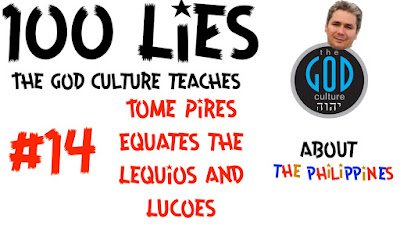
.png)

